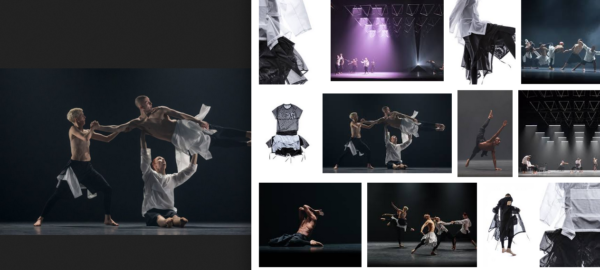Last week I saw two contemporary dance performances: the world premiere of Wayne McGregor’s ‘Autobiography’ at Sadlers Wells and The Michael Clark Company’s ‘to a simple rock n roll…song’ at Barbican. Both McGregor and Clark collaborated with iconic fashion designers for their wardrobes: McGregor with Aitor Throup and Clark with Stevie Stewart.
Throup created adaptable costumes for McGregor’s ‘Autobiography’, a dance of 23 dance sections in response to the choreographer’s individual genome sequence. Each night the dancer’s performed a random sequence of these sections, and the lightweight mesh clothes designed by Throup equally contained this unpredictable and interchangeable energy. A monochrome wardrobe of – what is also historically what McGregor’s own aesthetic consists of – shirts and shorts with fastening ties worn in a multitude of ways by the dancers, such as shirts tied around the waist, or with ties being left to hang loose.

The Michael Clark Company worked with Stevie Stewart, one-half of the influential 80s fashion label BodyMap for the costumes for his triple bill ‘to a simple rock n roll…song’. Clark and Stewart have worked together on the costumes for his dances since 1984, and for this triple bill of music-focused pieces, Stewart responded in collaboration with Clark to create costumes that reflected the energies of each choreographed embodiment of the different musical influences. For the first dance, which was to a stark piano piece by Erik Satie, the dancers’ costumes reminded me of piano keys where full-bodied longsleeve unitards of white torsos and black legs were worn. The following dance was to Patti Smith’s ‘Land’ and the dancers wore patent black flared leggings and white tops, with the lead dancer wearing a net-patterned top. For the David Bowie section of the performance, the costumes consisted of shimmering silver high-necked unitards and later on peach and orange glittering ones. One dancer wore all black (wide leg linen trousers and a longsleeve top), and a black pleated cape to cover her face for some of the dance to Bowie’s ‘Blackstar’, and she then twisted the cape around her and over her arms while she danced.
In Clark and McGregor’s collaborations with designers to create the costumes for their dances, we experience different approaches to how dancers interact with what they wear when they perform in line with the different focuses of the choreography: ‘To a simple rock n roll…song’ on music, ‘Autobiography’ on variation and McGregor’s own self.
By Evie Ward





